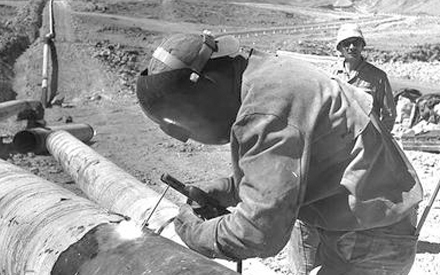
2019 –
After expiration of Eilat Ashkelon Pipeline Company Ltd.’s concession, the pipeline and port operations were transferred to Europe Asia Pipeline Company Ltd.
2018 –
EAPC marked 50 years of activity. As part of the State of Israel’s 70th anniversary celebrations, the History Channel launched the “Founding Companies” project. As part of this project, a short movie showing the company’s history from its establishment to the present day was produced. To watch the movie, please press here
2017 –
49 years after it was granted, EAPC’s Petroleum Pipeline Concession Deed expired. In March 2017, a new law was enacted, the Infrastructures for the Transportation and Storage of Oil by an Operating Entity Law, 2017. This law enabled the continued operation of the facilities.
2011 –
EAPC completed the construction of 8 crude oil storage tanks which enlarge the company’s storage capacity with an additional 770,000 cubic meters.
2010 –
The capacity at the LPG terminal grew to 7,900 tons.
2009 –
EAPC expanded its oil products’ storage capacity up to 400,000 cubic meters. Simultaneously, the company started the expansion of its crude oil storage capacity by an additional 500,000 cubic meters.
2007 –
The capacity at the LPG terminal grew to 6,500 tons. Several crude oil tanks were converted and serve now for oil products’ storage.
2004 –
EAPC completed the construction of a modern filling plant for LPG cylinders.
2003 –
The Reverse Flow Project was completed.
EAPC has the ability to pump crude oil in both directions, i.e., from the Mediterranean to the Red Sea and vice versa. The first VLCC called at Eilat Oil Port for loading.
2002 –
The capacity at the LPG terminal grew to 4,500 tons. Storage tanks were converted for distillates and a filling station for tanker lorries was constructed.
2000 –
EAPC begins to supply marine services to IEC (Israel Electric Company) through their Coal Jetty at EAPC’s Ashkelon port for the Rutenberg Power Station.
1999 –
As part of a joint venture between EAPC and PEI (“Petroleum and Energy Infrastructures Ltd.”), a multibuoy berth was converted to discharge distillates. Distillates (Gasoline, Kerosene and Gas Oil) are unloaded at the Ashkelon Port by EAPC and pumped by PEI into the national distillates networks.
1998 –
A modern LPG terminal, including a sea port with a capacity of 1,500 tons, was built. The terminal unloaded LPG from ocean going tankers and dispensed it into tanker lorries for national distribution.
1996 –
A sea and land terminal for fuel oil was built and began operations in Ashkelon, for the local market and for international needs.
1973 –
Storage capacity was expanded, in Eilat to 1,100,000 cu.m. and in Ashkelon to 1,300,000 cu.m. Another Booster Station was built in Yotvata. An 18″ pipeline was laid from Ashkelon to the Ashdod refinery.
1968 –
The company “Eilat Ashkelon Pipeline Company Ltd.” (EAPC) was established to build and operate a new project, which included laying of a 42″ from Eilat to Ashkelon. As part of this project, a crude oil terminal and a port were constructed in Ashkelon.
The second Eilat Jetty was built.
1966 –
A storage facility was built in Ramat Yotam including pumping stations from the Sea shore terminal to the site. The first Eilat Jetty was completed. A Booster Station was built in Paran.
1959 –
Due to the growing needs of the country, a 16″ pipeline was laid from Eilat to Haifa, at a flow rate of 170 cu.m per hour. A new company, the “Eilat Pipeline Co.” (EPC), was established to operate this pipeline. Over the next few years the storage capacity in Eilat grew and so did the flow capacity from Eilat to Haifa.
1957 –
The original infrastructure of the company was laid:
3 tanks were constructed in Eilat, an 8″ pipeline was laid from Eilat to Beer-Sheva, 3 tanks were built in Beer-Sheva, from there the crude oil was transported by train to Haifa. Later, a 16″ pipeline was laid from Beer-Sheva to Ashdod, from which crude oil was transported by ships to Haifa.
1956 –
In order to ensure a regular supply of crude oil to Israel, “Afike Neft” (Crude Oil Channel), a government owned company, was founded. This company received crude oil and transported it to the refinery in Haifa.






